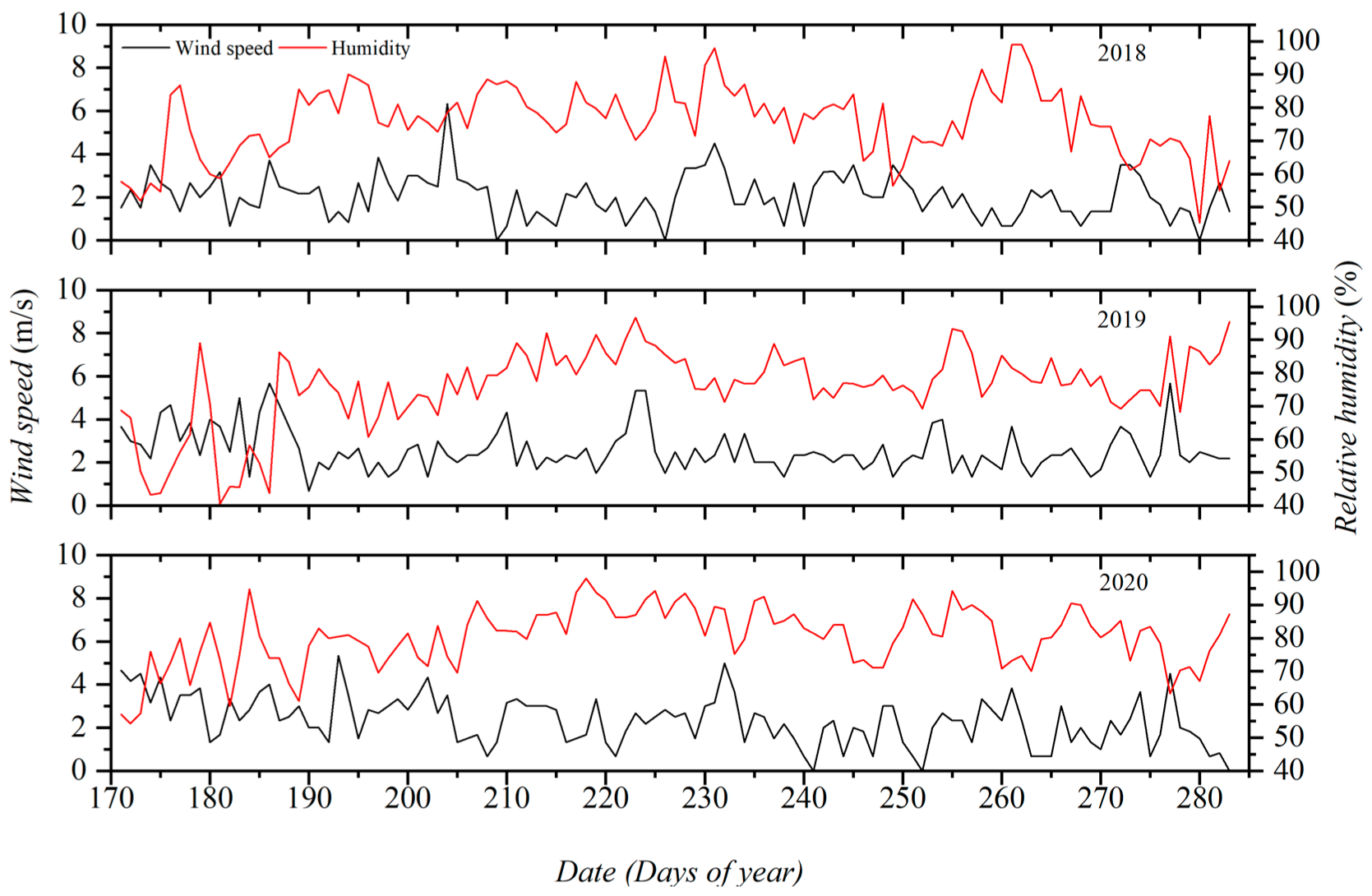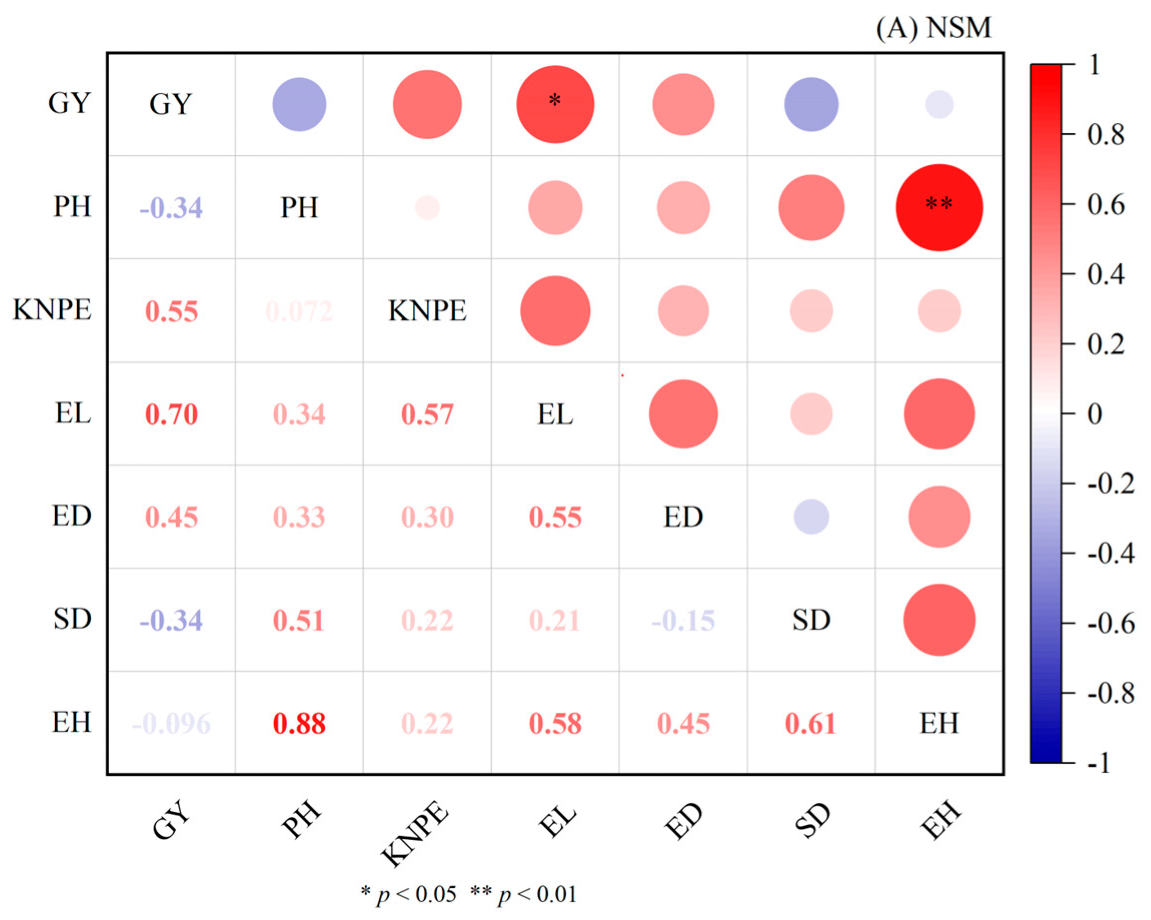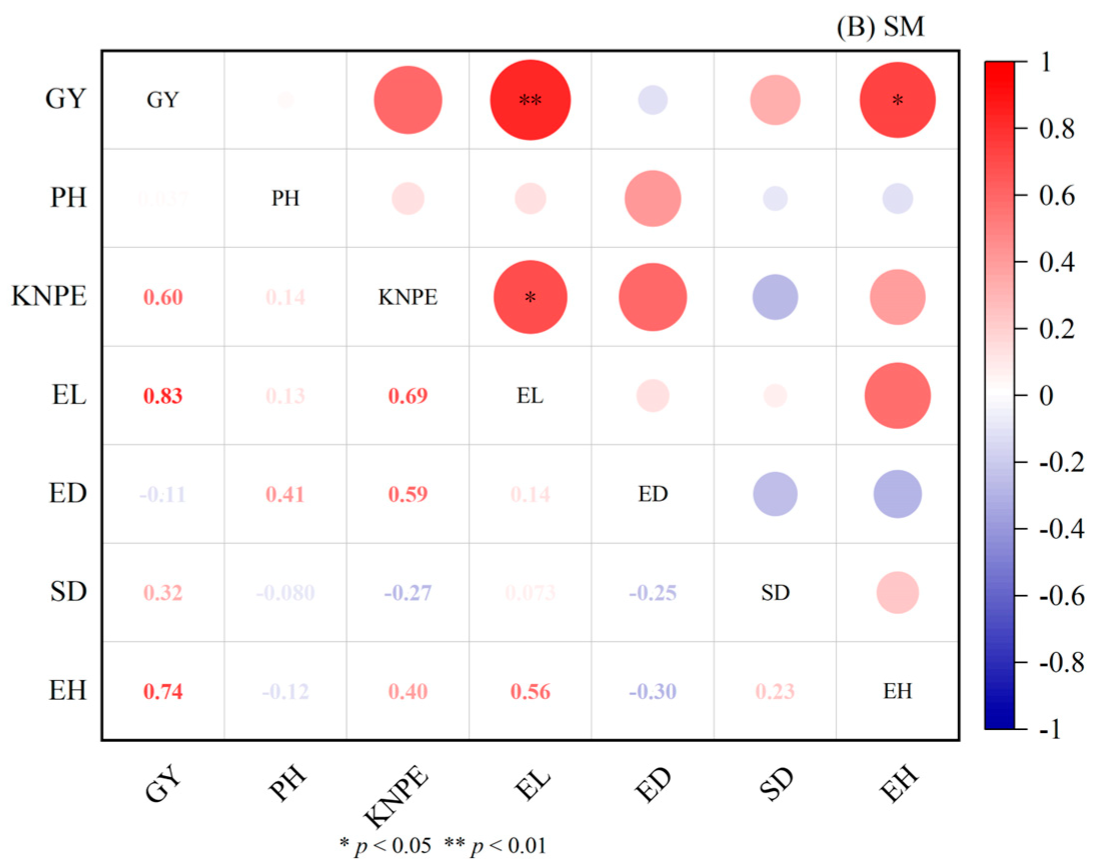Straw Mulching and Weather Conditions Affecting the Trade-Off Between Grain Yield and Agronomic Traits of Maize
Abstract
1. Introduction
2. Materials and Methods
2.1. Site Description
2.2. Field Management and Experimental Design
2.3. Crop Yield and Agronomic Characteristic Measurements
2.4. Meteorological Analysis
2.5. Statistical Analysis
3. Results
3.1. Grain Yield and Agronomic Traits
3.2. Relationships Between GY and Agronomic Characteristics
3.3. Influence of Weather Conditions
4. Discussion
4.1. The Influence of SM on GY and Agronomic Traits
4.2. The Influence of Weather Conditions on GY and Agronomic Traits
5. Conclusions
Author Contributions
Funding
Data Availability Statement
Acknowledgments
Conflicts of Interest
References
- FAO. World Food and Agriculture-Statistical Yearbook 2023; FAO: Rome, Italy, 2023. [Google Scholar]
- Iqbal, N.; Hussain, S.; Ahmed, Z.; Yang, F.; Wang, X.C.; Liu, W.G.; Yong, T.W.; Du, J.B.; Shu, K.; Yang, W.Y.; et al. Comparative analysis of maize-soybean strip intercropping systems: A review. Plant Prod. Sci. 2019, 22, 131–142. [Google Scholar] [CrossRef]
- Liu, S.P.; Wang, L.X.; Chang, L.; Khan, I.; Nadeem, F.; Rehman, A.; Suo, R. Evaluating the influence of straw mulching and intercropping on nitrogen uptake, crop growth, and yield performance in maize and soybean. Front. Plant Sci. 2023, 14, 1280382. [Google Scholar] [CrossRef] [PubMed]
- Li, T.; Zhang, X.P.; Liu, Q.; Liu, J.; Chen, Y.Q.; Sui, P. Yield penalty of maize (Zea mays L.) under heat stress in different growth stages: A review. J. Integr. Agric. 2022, 21, 2465–2476. [Google Scholar] [CrossRef]
- Liu, Y.E.; Hou, P.; Huang, G.R.; Zhong, X.L.; Li, H.R.; Zhao, J.R.; Li, S.K.; Mei, X.R. Maize grain yield and water use efficiency in relation to climatic factors and plant population in northern China. J. Integr. Agric. 2021, 20, 3156–3169. [Google Scholar] [CrossRef]
- Li, J.; Guo, Z.; Ye, S.L. Minor straw return enhances net income in a maize-wheat rotation system. Front. Environ. Sci. 2024, 12, 1343751. [Google Scholar] [CrossRef]
- Khan, I.; Luan, C.; Qi, W.; Wang, X.M.; Yu, B.H.; Rehman, A.; Khan, A.A.; Khan, J.; Wang, L.X. The residual impact of straw mulch and biochar amendments on grain quality and amino acid contents of rainfed maize crop. J. Plant Nutr. 2023, 46, 1283–1295. [Google Scholar] [CrossRef]
- Wang, J.; Ghimire, R.; Fu, X.; Sainju, U.M.; Liu, W. Straw mulching increases precipitation storage rather than water use efficiency and dryland winter wheat yield. Agric. Water Manag. 2018, 206, 95–101. [Google Scholar] [CrossRef]
- Xie, W.; He, P.; Ma, H.; Huang, X.; Fan, G.; Yang, H. Straw Mulching Combined with Phosphorus Fertilizer Increases Fertile Florets of Wheat by Enhancing Leaf Photosynthesis and Assimilate Utilization. Agronomy 2023, 13, 2342. [Google Scholar] [CrossRef]
- Kinkel, L.L.; Bakker, M.G.; Schlatter, D.C. A Coevolutionary Framework for Managing Disease-Suppressive Soils. Annu. Rev. Phytopathol. 2011, 49, 47–67. [Google Scholar] [CrossRef]
- Htun, Y.M.; Tong, Y.A.; Gao, P.C.; Ju, X.T. Coupled effects of straw and nitrogen management on N2O and CH4 emissions of rainfed agriculture in Northwest China. Atmos. Environ. 2017, 157, 156–166. [Google Scholar] [CrossRef]
- Pittelkow, C.M.; Liang, X.Q.; Linquist, B.A.; van Groenigen, K.J.; Lee, J.; Lundy, M.E.; van Gestel, N.; Six, J.; Venterea, R.T.; van Kessel, C. Productivity limits and potentials of the principles of conservation agriculture. Nature 2015, 517, 365–368. [Google Scholar] [CrossRef] [PubMed]
- Bathiany, S.; Belleflamme, A.; El Zohbi, J.; Ney, P.; Goergen, K.; Rechid, D. Increasing interannual climate variability during crop flowering in Europe. Environ. Res. Lett. 2023, 18, 044037. [Google Scholar] [CrossRef]
- Mondal, S.; Mishra, A.K.; Leung, R.; Cook, B. Global droughts connected by linkages between drought hubs. Nat. Commun. 2023, 14, 144. [Google Scholar] [CrossRef] [PubMed]
- Wang, Y.Q.; Zhang, Y.H.; Zhang, R.; Li, J.P.; Zhang, M.; Zhou, S.L.; Wang, Z.M. Reduced irrigation increases the water use efficiency and productivity of winter wheat-summer maize rotation on the North China Plain. Sci. Total Environ. 2018, 618, 112–120. [Google Scholar] [CrossRef] [PubMed]
- Ray, D.K.; Gerber, J.S.; MacDonald, G.K.; West, P.C. Climate variation explains a third of global crop yield variability. Nat. Commun. 2015, 6, 5989. [Google Scholar] [CrossRef]
- Hou, P.; Liu, Y.E.; Liu, W.M.; Yang, H.S.; Xie, R.Z.; Wang, K.R.; Ming, B.; Liu, G.Z.; Xue, J.; Wang, Y.H.; et al. Quantifying maize grain yield losses caused by climate change based on extensive field data across China. Resour. Conserv. Recycl. 2021, 174, 105811. [Google Scholar] [CrossRef]
- Killi, D.; Bussotti, F.; Raschi, A.; Haworth, M. Adaptation to high temperature mitigates the impact of water deficit during combined heat and drought stress in C3 sunflower and C4 maize varieties with contrasting drought tolerance. Physiol. Plant 2017, 159, 130–147. [Google Scholar] [CrossRef]
- Chen, C.; Baethgen, W.E.; Robertson, A. Contributions of individual variation in temperature, solar radiation and precipitation to crop yield in the North China Plain, 1961–2003. Clim. Chang. 2013, 116, 767–788. [Google Scholar] [CrossRef]
- Yang, Y.S.; Guo, X.X.; Liu, G.Z.; Liu, W.M.; Xue, J.; Ming, B.; Xie, R.Z.; Wang, K.R.; Hou, P.; Li, S.K. Solar Radiation Effects on Dry Matter Accumulations and Transfer in Maize. Front. Plant Sci. 2021, 12, 727134. [Google Scholar] [CrossRef]
- Li, H.; Cao, Y.; Wang, X.M.; Ge, X.; Li, B.Q.; Jin, C.Q. Evaluation on the Production of Food Crop Straw in China from 2006 to 2014. BioEnergy Res. 2017, 10, 949–957. [Google Scholar] [CrossRef]
- Zhao, X.; Li, F.; Ai, Z.; Li, J.; Gu, C. Stable isotope evidences for identifying crop water uptake in a typical winter wheat-summer maize rotation field in the North China Plain. Sci. Total Environ. 2018, 618, 121–131. [Google Scholar] [CrossRef] [PubMed]
- Du, K.; Li, F.; Leng, P.; Li, Z.; Tian, C.; Qiao, Y.; Li, Z. Differential influence of no-tillage and precipitation pulses on soil heterotrophic and autotrophic respiration of summer maize in the North China Plain. Agronomy 2020, 10, 2004. [Google Scholar] [CrossRef]
- Du, K.; Li, F.; Qiao, Y.; Leng, P.; Li, Z.; Ge, J.; Yang, G. Influence of no-tillage and precipitation pulse on continuous soil respiration of summer maize affected by soil water in the North China Plain. Sci. Total Environ. 2021, 766, 144384. [Google Scholar] [CrossRef]
- Li, Z.; Zhang, Q.; Qiao, Y.; Du, K.; Li, Z.; Tian, C.; Zhu, N.; Leng, P.; Yue, Z.; Cheng, H.; et al. Trade-offs between high yields and soil CO2 emissions in semi-humid maize cropland in northern China. Soil Tillage Res. 2022, 221, 105412. [Google Scholar] [CrossRef]
- Yang, H.S.; Dobermann, A.; Lindquist, J.L.; Walters, D.T.; Arkebauer, T.J.; Cassman, K.G. Hybrid-maize—A maize simulation model that combines two crop modeling approaches. Field Crops Res. 2004, 87, 131–154. [Google Scholar] [CrossRef]
- Butler, E.E.; Huybers, P. Adaptation of US maize to temperature variations. Nat. Clim. Chang. 2013, 3, 68–72. [Google Scholar] [CrossRef]
- Ge, J.Z.; Xu, Y.; Zhao, M.; Zhan, M.; Cao, C.G.; Chen, C.Y.; Zhou, B.Y. Effect of Climatic Conditions Caused by Seasons on Maize Yield, Kernel Filling and Weight in Central China. Agronomy 2022, 12, 1816. [Google Scholar] [CrossRef]
- Das, S.; Kaur, S.; Sharma, V. Determination of threshold crop water stress index for sub-surface drip irrigated maize-wheat cropping sequence in semi-arid region of Punjab. Agric. Water Manag. 2024, 301, 108957. [Google Scholar] [CrossRef]
- Srock, A.F.; Charney, J.J.; Potter, B.E.; Goodrick, S.L. The hot-dry-windy index: A new fire weather index. Atmosphere 2018, 9, 9070279. [Google Scholar] [CrossRef]
- Qin, A.Z.; Ning, D.F.; Liu, Z.D.; Li, S.; Zhao, B.; Duan, A.W. Determining Threshold Values for a Crop Water Stress Index-Based Center Pivot Irrigation with Optimum Grain Yield. Agriculture 2021, 11, 11100958. [Google Scholar] [CrossRef]
- Chen, G.H.; Weil, R.R. Root growth and yield of maize as affected by soil compaction and cover crops. Soil Tillage Res. 2011, 117, 17–27. [Google Scholar] [CrossRef]
- Khan, I.; Chen, T.T.; Farooq, M.; Ce, L.; Qi, W.; Dai, W.N.; Su, X.; Wang, L.X. The residual impact of straw mulch and biochar amendments on soil physiochemical properties and yield of maize under rainfed system. Agron. J. 2021, 113, 1102–1120. [Google Scholar] [CrossRef]
- Retta, M.; Yin, X.Y.; van der Putten, P.E.; Cantre, D.; Berghuijs, H.C.; Ho, Q.T.; Verboven, P.; Struik, P.C.; Nicolaï, B.M. Impact of anatomical traits of maize (Zea mays L.) leaf as affected by nitrogen supply and leaf age on bundle sheath conductance. Plant Sci. 2016, 252, 205–214. [Google Scholar] [CrossRef] [PubMed]
- Zhai, L.C.; Wang, Z.A.; Song, S.J.; Zhang, L.H.; Zhang, Z.B.; Jia, X.L. Tillage practices affects the grain filling of inferior kernel of summer maize by regulating soil water content and photosynthetic capacity. Agric. Water Manag. 2021, 245, 106600. [Google Scholar] [CrossRef]
- Ma, L.J.; Kong, F.X.; Wang, Z.; Luo, Y.; Lv, X.B.; Zhou, Z.G.; Meng, Y.L. Growth and yield of cotton as affected by different straw returning modes with an equivalent carbon input. Field Crops Res. 2019, 243, 107616. [Google Scholar] [CrossRef]
- Yu, C.R.; Wang, X.J.; Hu, B.; Yang, C.Q.; Sui, N.; Liu, R.X.; Meng, Y.L.; Zhou, Z.G. Effects of wheat straw incorporation in cotton-wheat double cropping system on nutrient status and growth in cotton. Field Crops Res. 2016, 197, 39–51. [Google Scholar] [CrossRef]
- Zhao, L.; Xie, G.; Fan, M.; Anwar, S.; Zhang, Q.; Lu, J.; Zhang, L.; Gao, F.; Wang, C. Mulching and Planting Density on Photosynthesis, Lodging Resistance, and Yield of Maize. Int. J. Plant Prod. 2023, 17, 651–665. [Google Scholar] [CrossRef]
- Hemmat, A.; Eskandari, I. Dryland winter wheat response to conservation tillage in a continuous cropping system in northwestern Iran. Soil Tillage Res. 2006, 86, 99–109. [Google Scholar] [CrossRef]
- Moore, P.D. Plant physiology—High hopes for C4 plants. Nature 1994, 367, 322–323. [Google Scholar] [CrossRef]
- Zhao, C.; Liu, B.; Piao, S.; Wang, X.; Lobell, D.B.; Huang, Y.; Huang, M.; Yao, Y.; Bassu, S.; Ciais, P.; et al. Temperature increase reduces global yields of major crops in four independent estimates. Proc. Natl. Acad. Sci. USA 2017, 114, 9326–9331. [Google Scholar] [CrossRef]
- Wang, Y.Y.; Sheng, D.C.; Zhang, P.; Dong, X.; Yan, Y.; Hou, X.F.; Wang, P.; Huang, S.B. High temperature sensitivity of kernel formation in different short periods around silking in maize. Environ. Exp. Bot. 2021, 183, 104343. [Google Scholar] [CrossRef]
- Wang, J.; Wang, E.; Yang, X.; Zhang, F.; Yin, H. Increased yield potential of wheat-maize cropping system in the North China Plain by climate change adaptation. Clim. Chang. 2012, 113, 825–840. [Google Scholar] [CrossRef]
- Noia, R.D., Jr.; Deswarte, J.C.; Cohan, J.P.; Martre, P.; van der Velde, M.; Lecerf, R.; Webber, H.; Ewert, F.; Ruane, A.C.; Slafer, G.A.; et al. The extreme 2016 wheat yield failure in France. Glob. Chang. Biol. 2023, 29, 3130–3146. [Google Scholar]
- Niu, S.; Du, X.; Wei, D.; Liu, S.; Tang, Q.; Bian, D.; Zhang, Y.; Cui, Y.; Gao, Z. Heat Stress After Pollination Reduces Kernel Number in Maize by Insufficient Assimilates. Front. Genet. 2021, 12, 728166. [Google Scholar] [CrossRef]
- Zhang, Z.; Wang, P.; Chen, Y.; Song, X.; Wei, X.; Shi, P. Global warming over 1960–2009 did increase heat stress and reduce cold stress in the major rice-planting areas across China. Eur. J. Agron. 2014, 59, 49–56. [Google Scholar] [CrossRef]
- IPCC. Summary for Policymakers. In Climate Change 2021: The Physical Science Basis. Contribution of Working Group I to the Sixth Assessment Report of the Intergovernmental Panel on Climate Change; Cambridge University Press: Cambridge, UK, 2021. [Google Scholar]




| Year | TP (mm) | AT (°C) | Max T (°C) | Min T (°C) | RH (%) | WS |
|---|---|---|---|---|---|---|
| 2018 | 472.9 | 25.5 | 37.3 | 1.4 | 75.90 | 2.03 |
| 2019 | 220.3 | 24.9 | 38.6 | 7.4 | 75.85 | 2.57 |
| 2020 | 443.2 | 23.8 | 36.6 | 2.0 | 80.34 | 2.33 |
| Mean | 378.8 | 24.7 | 37.5 | 3.6 | 77.36 | 2.31 |
| Years | Groups | GY | PH | KNPE | EL | ED | SD | EH |
|---|---|---|---|---|---|---|---|---|
| 2018 | NSM | 4.89 ± 0.34 a | 217.20 ± 6.13 a | 520.55 ± 7.25 a | 20.70 ± 0.57 a | 4.84 ± 0.06 a | 2.10 ± 0.04 a | 82.50 ± 0.28 a |
| SM | 6.43 ± 0.91 b | 218.90 ± 11.70 a | 481.40 ± 46.11 a | 19.47 ± 2.02 a | 4.88 ± 0.05 a | 2.08 ± 0.13 a | 90.03 ± 6.95 b | |
| 2019 | NSM | 3.92 ± 0.39 a | 208.93 ± 8.84 a | 485.03 ± 19.58 a | 17.17 ± 0.79 a | 4.82 ± 0.09 a | 1.58 ± 0.07 a | 74.52 ± 3.13 a |
| SM | 4.85 ± 0.63 b | 226.15 ± 7.29 b | 509.68 ± 44.23 a | 18.13 ± 1.64 a | 5.01 ± 0.05 b | 1.63 ± 0.09 a | 82.43 ± 3.01 a | |
| 2020 | NSM | 6.50 ± 0.49 a | 200.30 ± 15.30 a | 514.27 ± 38.86 a | 20.90 ± 1.24 a | 4.91 ± 0.08 a | 1.44 ± 0.02 a | 74.67 ± 7.31 a |
| SM | 7.16 ± 0.44 a | 234.20 ± 1.10 b | 551.48 ± 36.11 a | 21.93 ± 1.51 a | 4.97 ± 0.09 a | 1.76 ± 0.12 b | 88.53 ± 3.75 b | |
| Mean | NSM | 5.10 ± 0.09 a | 208.81 ± 4.55 a | 34.94 ± 1.37 a | 19.59 ± 0.40 a | 4.86 ± 0.02 a | 1.70 ± 0.03 a | 77.23 ± 2.30 a |
| SM | 6.15 ± 0.38 b | 226.42 ± 4.01 b | 35.46 ± 1.64 a | 19.84 ± 1.11 a | 4.96 ± 0.03 b | 1.82 ± 0.05 a | 87.00 ± 1.95 b |
| Treatments | GY | PH | KNPE | EL | ED | SD | EH |
|---|---|---|---|---|---|---|---|
| Straw Management | 0.003 ** | 0.007 ** | 0.725 | 0.755 | 0.038 * | 0.043 * | 0.004 ** |
| Years | <0.001 ** | 0.993 | 0.326 | 0.007 ** | 0.290 | <0.001 ** | 0.105 |
| Straw Management * Years | 0.451 | 0.095 | 0.293 | 0.446 | 0.299 | 0.034 * | 0.585 |
| Item | Standard Coefficients | Adjusted R2 | p-Value |
|---|---|---|---|
| Plant height | GDD (1.261), T MIN (−0.266) | 0.995 | 0.031 |
| Kernel numbers per ear | GDD (0.993), T MIN (0.069) | 0.996 | 0.011 |
| Ear length | Tmax (−1.012), HDW (0.013) | 0.999 | 0.003 |
| Ear diameter | GDD (−1.162), T MIN (0.165) | 0.998 | 0.006 |
| Stem diameter | NS | − | − |
| Ear height | NS | − | − |
Disclaimer/Publisher’s Note: The statements, opinions and data contained in all publications are solely those of the individual author(s) and contributor(s) and not of MDPI and/or the editor(s). MDPI and/or the editor(s) disclaim responsibility for any injury to people or property resulting from any ideas, methods, instructions or products referred to in the content. |
© 2024 by the authors. Licensee MDPI, Basel, Switzerland. This article is an open access article distributed under the terms and conditions of the Creative Commons Attribution (CC BY) license (https://creativecommons.org/licenses/by/4.0/).
Share and Cite
Du, K.; Li, Z.; Li, F. Straw Mulching and Weather Conditions Affecting the Trade-Off Between Grain Yield and Agronomic Traits of Maize. Agronomy 2024, 14, 2686. https://doi.org/10.3390/agronomy14112686
Du K, Li Z, Li F. Straw Mulching and Weather Conditions Affecting the Trade-Off Between Grain Yield and Agronomic Traits of Maize. Agronomy. 2024; 14(11):2686. https://doi.org/10.3390/agronomy14112686
Chicago/Turabian StyleDu, Kun, Zhao Li, and Fadong Li. 2024. "Straw Mulching and Weather Conditions Affecting the Trade-Off Between Grain Yield and Agronomic Traits of Maize" Agronomy 14, no. 11: 2686. https://doi.org/10.3390/agronomy14112686
APA StyleDu, K., Li, Z., & Li, F. (2024). Straw Mulching and Weather Conditions Affecting the Trade-Off Between Grain Yield and Agronomic Traits of Maize. Agronomy, 14(11), 2686. https://doi.org/10.3390/agronomy14112686







